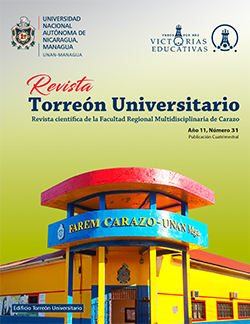Inhibitory activity of leaf and bark extracts of the Tree Tetragastris panamensis (Engl.) Kuntze, on in vitro growth of Moniliopthora roreri (cif) H.C.Evans, Stalpers, Samson & Benny. (1978), Biology Laboratory, UNAN- MANAGUA, 2021
DOI:
https://doi.org/10.5377/rtu.v11i31.14228Keywords:
Inhibitory activity, fungicidal action, minimum inhibitory concentrationAbstract
This research was carried out to evaluate the inhibitory activity of the extracts at different concentrations of bark and leaf of Tetragastris panamensis (Engl.) Kuntze on in vitro growth of Moniliopthora roreri (cif) H.C. Evans, Stalpers, Samson & Benny. ( 1978). The experiment consisted of three phases: first, the Soxhlet method was used to extract the oils by matrices and estimate their efficiency, then, a fungal susceptibility analysis was carried out where the method used was that of diffusion in agar Kirby-Bauer modifying it for the phytopathogen, finally, the minimum inhibitory concentration of the extracts of both matrices was determined using the serial dilution method, for all these processes, the variables temperature, time and exposure to light were controlled. The result was analyzed from the application of mixed methods integrating both quantitative and qualitative approaches which allowed us to verify that both matrices have fungicidal action. However, bark oil has greater fungicidal activity compared to phytopathogen.
Article derived from monographic thesis entitled: Inhibitory activity of leaf extracts and bark of the tree Tetragastris panamensis (Engl.) Kuntze, on in vitro growth of Moniliopthora roreri (cif) H.C.Evans, Stalpers, Samson & Benny. (1978), Biology laboratory, UNAN-MANAGUA, 2021. In the period from January to October 2021.
Downloads
References
Caldas Avila, A. P. (2012). Optimización, escalamiento y diseño de una planta piloto de extracción sólido líquido. Cuenca: Universidad de Cuenca.
Ceballos, M. A. (2012). ANÁLISIS DE PARÁMETROS MICROBIOLÓGICOS. Guatemala.
Diaz-Granados, C. D., & Chaparro-Giraldo, A. (2011). Concentración mínima inhibitoria de Kanamicina para callos de cuatro variedades colombianas de arroz. Revista Colombiana de Biotecnologia, 11.
Obando, M. (2015). Producción moderna del cacao (Theobroma cacao). Managua: INTA. Oporta, E. (10 de Mayo de 2020). Produccion de Cacao 2020. Managua: El 19 digital.
Querol, D. (1996). Especies utiles de un bosque humedo tropical. Lima: INDUSTRIALgrafica S.A.
Piura López, J. (2008). Metodología de la investigación cientifíca- Un enfoque integrador. Managua: 6ta ed.- Managua: Xerox.
Soto Macetas, R., & Ramirez Heredia, R. (2018). "Efecto antibacteriano del aceite de las hojas de Molle (Schinus Molle. L) frente a cepas de Escherichia Coli" in vitr. Lima. Lima.
Arango, N. A., Vanegas, N. B., García, C. M., & Rojano, B. (1 de Mayo de 2007). actividad antifungica del isoespintanol sobre hongos del genero colletotricum. medellin., Medellin, Colombia.
Barrera, F. O., & Espinoza, P. C. (2002). Marcha fitoquímica y actividad citotóxica con Artemia Salina de la corteza del arbol Tetragastris panamensis (Kerosin). Nicaragua.: UNAN-LEON.
Gómez, M. O. (.). Metodología de la Investigación. Universidad Hispanoamericana: Campus San Jerónimo.
Jaramillo, B. E., Duarte, E., y Delgado, W. (2012). Bioactividad del aceite esencial de Chenopodium ambrosioides colombiano. Revista Cubana de Plantas Medicinales, 17.
María José Usaquén Ramírez, m. a. (2018). evaluación del proceso de obtención de aceite esencial a nivel laboratorio. bogotá.
Mondino, D. P. (2012). Métodos de aislamiento. Unidad de Fitopatología.
Published
How to Cite
Issue
Section
License
Copyright (c) 2022 National Autonomous University of Nicaragua, Managua.

This work is licensed under a Creative Commons Attribution-NonCommercial-NoDerivatives 4.0 International License.
The authors who publish in this journal agree to the following terms.
- The author or authors of the articles, essays or research grant the National Autonomous University of Nicaragua, Managua (UNAN-Managua) the editing rights (copyright) of the submitted work, therefore the University has the exclusive right to publish the article for the entire copyright period.
- These copyrights/authors authorize Torreón Universitario Magazine and the University to edit and disseminate/publish the article in said Magazine, including printed and electronic reproduction, storage, retrieval and any other type of publication, and sources of secondary information as services. of summaries and databases, they also empower it to protect the article against unauthorized use for dissemination by printed or electronic media (PDF, HTML, EPUB, XML or others).
License for use of content
The magazine uses the Creative Commons Attribution-NonCommercial-NoDerivs 4.0 International License.
Under this statement:

This journal is licensed under a Creative Commons Attribution-NonCommercial-NoDerivatives 4.0 International License. It can be copied, distributed and transmitted publicly as long as the author and source are cited (Revista Torreón Universitario), it should not be modified or used for any commercial purpose. The full license can be found at http://creativecommons.org/licenses/by-nc-nd/4.0/.



